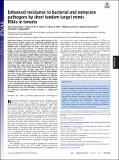Por favor, use este identificador para citar o enlazar a este item:
http://hdl.handle.net/10261/240291COMPARTIR / EXPORTAR:
 SHARE SHARE
 CORE
BASE CORE
BASE
|
|
| Visualizar otros formatos: MARC | Dublin Core | RDF | ORE | MODS | METS | DIDL | DATACITE | |

| Título: | Enhanced resistance to bacterial and oomycete pathogens by short tandem target mimic RNAs in tomato |
Autor: | Canto-Pastor, Alex; Santos, Bruno; Valli, Adrián; Summers, William; Schornack, S.; Baulcombe, David C. | Palabras clave: | microRNA NLR siRNA Quantitative disease resistance Noncoding RNA |
Fecha de publicación: | 2019 | Editor: | National Academy of Sciences (U.S.) | Citación: | Proceedings of the National Academy of Sciences of the United States of America 116(7): 2755-2760 (2019) | Resumen: | Nucleotide binding site leucine-rich repeat (NLR) proteins of the plant innate immune system are negatively regulated by the miR482/2118 family miRNAs that are in a distinct 22-nt class of miRNAs with a double mode of action. First, they cleave the target RNA, as with the canonical 21-nt miRNAs, and second, they trigger secondary siRNA production using the target RNA as a template. Here, we address the extent to which the miR482/2118 family affects expression of NLR mRNAs and disease resistance. We show that structural differences of miR482/2118 family members in tomato (Solanum lycopersicum) are functionally significant. The predicted target of the miR482 subfamily is a conserved motif in multiple NLR mRNAs, whereas for miR2118b, it is a noncoding RNA target formed by rearrangement of several different NLR genes. From RNA sequencing and degradome data in lines expressing short tandem target mimic (STTM) RNAs of miR482/2118, we confirm the different targets of these miRNAs. The effect on NLR mRNA accumulation is slight, but nevertheless, the tomato STTM lines display enhanced resistance to infection with the oomycete and bacterial pathogens. These data implicate an RNA cascade of miRNAs and secondary siRNAs in the regulation of NLR RNAs and show that the encoded NLR proteins have a role in quantitative disease resistance in addition to dominant gene resistance that has been well characterized elsewhere. We also illustrate the use of STTM RNA in a biotechnological approach for enhancing quantitative disease resistance in highly bred cultivars. | Versión del editor: | http://dx.doi.org/10.1073/pnas.1814380116 | URI: | http://hdl.handle.net/10261/240291 | DOI: | 10.1073/pnas.1814380116 | Identificadores: | doi: 10.1073/pnas.1814380116 issn: 0027-8424 e-issn: 1091-6490 |
| Aparece en las colecciones: | (CNB) Artículos |
Ficheros en este ítem:
| Fichero | Descripción | Tamaño | Formato | |
|---|---|---|---|---|
| Enhanced_Canto_PV_Art2019.pdf | 945,19 kB | Adobe PDF |  Visualizar/Abrir |
CORE Recommender
PubMed Central
Citations
45
checked on 17-abr-2024
SCOPUSTM
Citations
90
checked on 15-abr-2024
WEB OF SCIENCETM
Citations
76
checked on 28-feb-2024
Page view(s)
51
checked on 19-abr-2024
Download(s)
84
checked on 19-abr-2024

